What is "uki-yo"?:
"Uki-yo" literally means "floating world". The concept of "uki-yo" came from Buddhist or Taoist understanding of this world and means that the life in this world is neither firm nor reliable, like grass on the flowing water.
"Uki" (floating) "yo"(world) became "uki" (gloomy) world under the influence of pessimism of Japanese Buddhism at the end of the ancient time. However, when the medieval time ended, the age characterized by the civil war and social mobility came and it gave "uki-yo" another concept, namely "uki uki" (joyful) world. Ukiyo-e ("pictures of the floating world") succeeds such positive concept of the world.
Ukiyo-e is related to the amusement of ordinary and vulgar people of the Edo period. Its themes encompass all imaginable kinds of entertainment such as scenic spots, beautiful girls, actors and pornography.
Ukiyo-e and Kabuki:
It is, however, unmistakable that Kabuki theater was the most important genre of ukiyo-e. Especially at the end of the Edo period the most popular ukiyo-e painters were those who draw portraits of Kabuki actors. The representative names are such as
Toyokuni I,
Kunisada (Toyokuni III),
Kuniyoshi,
Kunichika and
Yoshiiku.
I am sure to say that
Hiroshige and
Hokusai became famous for their landscape pictures, because they were not good at drawing actors and forced to find their way in another area.
As photography was not prevailing yet before the 1860s, ukiyo-e is the sole tool for us to view Kabuki in those days. We owe therefore much to the capable ukiyo-e artists in tracing back the tradition of the Kabuki theater.
Ukiyo-e and Kabuki:
This set of three ukiyo-e prints was drawn by Gototei Kunisada.
On each paper one actor is featured together with the actor's name and the role's name. I can therefore immediately see, though the title is not printed, that the play is "Sugawara Denju Tenarai Kagami" (made in 1746) which describes the life of Sugawara Michizane, a famous politician in the ancient aristocratic Japan. This scene handles the check of the head of a prince by a follower of the evil side.
The names of the actors on the print are from left to right,
Ono-e Eizaburo,
Sawamura Tossho and
Ichikawa Ebizo. This does not give us sufficient information to identify actors, because there are historically for instance more than 10 actors with the name of Ebizo.
Then, how can we identify this Ebizo on the print and know when and where the performance was made ?
It's not simple, but easy. Ukiyo-e gives you vital informations. So, ukiyo-e is not only a picture to appreciate its artistic beauty, but a very precious source to know the Kabuki world at the time.
Painter, printer, publisher and what?:
Painters' names give us important information in deciding the time of publication. For example, Kunisada changed his name to Toyokuni in 1844, so this print must have been published before 1844. The names of printers and publishers are important as well.
However,
the most important key is hidden in the censorship system at the time. Especially at the end of the Edo period every ukiyo-e print must be censored before publication and the censorship was executed by the guild of ukiyo-e publishers. The system differed depending on the period.
Identify the actor:
The ukiyo-e on the top of this page has only one

stamp ("Kiwame-in") as shown here enlarged in the first example. A Chinese character, which is encircled, was usually used for coins to assure the quality.
The single Kiwame-in system to show the execution of censorship continued from 1815 to 1842.
Solely from this fact we can deduce that Ebizo is
Ebizo V (1791 - 1859), because he is the Ebizo who was active during that time.
I can also strengthen my conclusion by many other indices. Unfortunately, the picture above does not have high resolution. But, if you can see it nearer, you can find
crests and other designs particular to Ebizo and Ichikawa family. So, even though actors' names are not explicitly printed, we can identify the actors from those signs.
After checking all such indices the assumption that Ebizo is Ebizo V seems certain.
Ebizo V was Danjuro (the most respectful Kabuki actor name) VII till
1832 when he gave the Danjuro name to his son (Danjuro VIII) and readopted his old name, Ebizo (Ebizo is usually the name used by the candidate for the next Danjuro.).
Identify the particular performance:
So, I can sufficiently narrow down the time span to the period between
1832 and 1842.
Then I can check in the Kabuki chronology when and where Sugawara was performed within this relatively short period of 11 years.
Sugawara is a very popular play, but I can pick up one performance from the combination of three actors for three roles: Matsuoumaru - Ichikawa Ebizo V , Genzo - Sawamura Tossho I and Chiyo - Onoe Eizaburo.
The performance at the Nakamura-za Theater which started on September 11, 1840 had this staffing.
Another examples:
I explain here briefly other two examples of censorship marks.
- Two stamps of two headmen, here
 and
and  (Muramatsu Genroku and Fukushima Giemon) indicate that the publication was made between 1847 and 1852.
(Muramatsu Genroku and Fukushima Giemon) indicate that the publication was made between 1847 and 1852.
- Another example has only one stamp
 , which has three characters within a circle. They mean the execution of censorship, its year according to Chinese calender (here ox) and month (here March). So we can easily identify that this is March 1862.
, which has three characters within a circle. They mean the execution of censorship, its year according to Chinese calender (here ox) and month (here March). So we can easily identify that this is March 1862.
Like this we can survey when and where the performance took place, and search into the time when those actors were active on the stage.
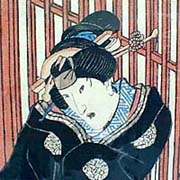 |
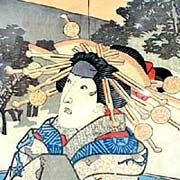 |
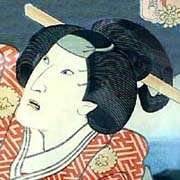 |
Eizaburo
(1840) |
Baiko IV
(1849) |
Kikugoro IV
(1860) |
Everybody looks alike on ukiyo-e?:
The actors' pictures are very much stylized, aren't they ? Especially after Kunisada (later Toyokuni III), we can see more stereotypes than characters of individual actors. Sometimes I am surprised to see photos of actors which were taken in the 1860s or 1870s because they are so different from the pictures on ukiyo-e prints !
However, people in Edo seem to have been able to distinguish actors on ukiyo-e prints. Maybe it was partly due to crests and other symbols I mentioned above.
But, ukiyo-e certainly has some sort of realism. Here above I put three pictures of the same actor from different periods. The picture on the left is enlarged from
the wide picture on the top of this page. Eizaburo (1808 - 1861) was 32 years old at the time. Then he changed name in 1846 and on the next photo he was 41. The picture right shows him as Kikugoro IV a year before his death at the age of 53. I can see on these three pictures unmistakable characteristics of his features.
The common feature of the tree pictures is, I think, the long face and characteristic nose line with a lower lip somewhat protruded.
He was presumably not a handsome figure :-P
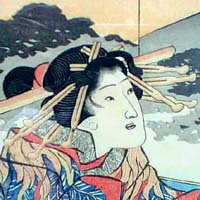
Iwai Kumesaburo |
Compare those pictures with another one here left. This is the picture of Kumesaburo at the age of 20. He later became one of the most popular actors at the beginning of the Meiji Period and famous for his beauty.
I have the impression that Kumesaburo here was drawn more beautifully than three pictures of Kikugoro IV above. Kikugoro IV was known as an actor good at performing presentable but older court lady. The examples of his pictures here endorse in fact this reputation.
O-Edo dewa,
Ichikawa nikawa shirane-domo,
Pin-to hanetaru Ebi-no me-no tama. |
Though not sure
whether he is No.1 or ("ichikawa"= the same pronounciation as Ebizo's family name) 2 in Edo,
He has eyeballs like those of a fresh lobster. ("ebi"= the same pronounciation as the first part his name "Ebizo") |
Ebizo V:
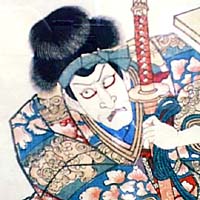
Ichikawa Ebizo V |
I also enlarged here the facial part of Ebizo V from
the picture at the top of this page. Ebizo was at the zenith of his career around 1840. He was the leading figure of the Edo Kabuki and competing the favor of zealous supporters with his son, Danjuro VIII.
In June 1842, however, he was banned from Edo under the strict Tempo Reform measures as a symbol of luxury and immoral life style. When the ban ended in 1849, the time had already changed and he could not restore his reputation in Edo. Several years later he was making performance in Osaka and invited his son, Danjuro VIII. Danjuro joined Ebizo but commit mysterious suicide in Osaka at the height of his popularity. Ebizo also passed away soon. Later, one of Ebizo's younger sons became Danjuro IX and lead the Kabuki theater scene in the Meiji Period.
The ukiyo-e picture which draws a face from its front is very rare. This picture shows very well the trade mark of Ebizo, extremely big, vivid and eloquent eyes.
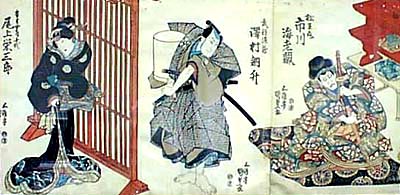
 stamp ("Kiwame-in") as shown here enlarged in the first example. A Chinese character, which is encircled, was usually used for coins to assure the quality. The single Kiwame-in system to show the execution of censorship continued from 1815 to 1842.
stamp ("Kiwame-in") as shown here enlarged in the first example. A Chinese character, which is encircled, was usually used for coins to assure the quality. The single Kiwame-in system to show the execution of censorship continued from 1815 to 1842. and
and  (Muramatsu Genroku and Fukushima Giemon) indicate that the publication was made between 1847 and 1852.
(Muramatsu Genroku and Fukushima Giemon) indicate that the publication was made between 1847 and 1852.
 , which has three characters within a circle. They mean the execution of censorship, its year according to Chinese calender (here ox) and month (here March). So we can easily identify that this is March 1862.
, which has three characters within a circle. They mean the execution of censorship, its year according to Chinese calender (here ox) and month (here March). So we can easily identify that this is March 1862. 



